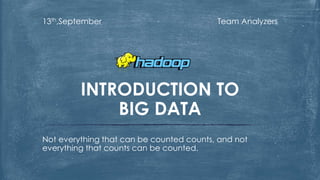
WELCOME TO BIG DATA TRANING
- 1. Team Analyzers13th,September Not everything that can be counted counts, and not everything that counts can be counted. INTRODUCTION TO BIG DATA
- 2. What are we going to cover today? Uses of Big Data What is Hadoop? Short intro to the HDFS architecture. What is Map Reduce? The components of Map Reduce Algorithm Hello world of map reduce i.e. Word Count Algorithm
- 3. Big data is an evolving term that describes any voluminous amount of structured, semi-structured and unstructured data that has the potential to be mined for information. What is Big Data?
- 4. Serial vs sequential processingSerial vs parallel processing WHY BIGDATA?
- 5. WHY BIGDATA?
- 6. WHY BIGDATA? Walmart has exhaustive customer data of close to 145 million Americans of which 60% of the data is of U.S adults. Walmart tracks and targets every consumer individually Walmart observed a significant 10% to 15% increase in online sales for $1 billion in incremental revenue.
- 7. WHY BIGDATA? Walmart has exhaustive customer data of close to 145 million Americans of which 60% of the data is of U.S adults. Walmart tracks and targets every consumer individually Walmart observed a significant 10% to 15% increase in online sales for $1 billion in incremental revenue.
- 10. HADOOP ECOSYSTEM
- 13. Map Phase Combiner Phase(Optional) Sort Phase Shuffle Phase Partition Phase(Optional) Reducer Phase Key points Map Reduce Algorithm
- 15. Hello my name is abhishek Hello my name is utsav Hello my passion is cricket Imagine this as the input file: Map Phase This file has 2 lines. Each line in the file has a byte offset of its own which serves as a key to the mapper and the value of the mapper is the data which is present In the line.
- 16. Operation on output of map phase Hello 1 my 1 name 1 is 1 abhishek 1 Hello 1 my 1 name 1 is 1 utsav 1 Hello 1 my 1 passion 1 is 1 cricket 1 Hello(1,1,1) my(1,1,1) name(1,1) is(1,1,1) abhishek(1) utsav(1) passion(1) cricket(1) Key(tuple of values)
- 17. The key points are as follows: Sort the key value pairs according to the key values Shuffle the mapped output to get values with same key to create a tuple of values with same key This output is fed to the reducer which in turn maps the values of the tuple by returning a single value for a list of values present in the tuple Explaination of sort and shuffle phase
- 18. Reducer phase Hello(1,1,1) my(1,1,1) name(1,1,1) is(1,1,1) abhishek(1) utsav(1) passion(1) cricket(1) Key(tuple of values) abhishek(1) cricket(1) Hello(3) is(3) my(3) name(3) passion(1) utsav(1) Key(single value)
- 19. Two types of splitting of input files are possible HDFS split: Splitting of files into blocks of fixed size e.g. splitting a file into blocks of 64 MB to promote parallel processing. N line split: Splitting of files into lines of fixed number of lines to promote parallel processing Lets see an example in the next slide Types of splits(Parallel processing in action):
- 20. Consider this as the input file: Map reduce is a framework based on processing of data paralelly. This algorithm consists of three phases namely map , shuffle and sort ,reduce. Here we will observe the effect of n line splitter on the number of map tasks i.e. the number of mappers created. This will create a better understanding on how a file splits. N LINE SPLITTING: Can you guess what will happen?????
- 21. Assume the value of n as 3 Map reduce is a framework based on processing of data paralelly. This algorithm consists of three phases namely map , shuffle and sort ,reduce. Here we will N LINE SPLITTING contd. observe the effect of n line splitter on the number of map tasks i.e. the number of mappers created. This will create a better understanding of how a file splits. So both of these splits of the file will be sent to two different mappers while in the case of HDFS split the amount of data being sent to mappers depends on the size of the respective splits
- 22. Hadoop uses its own serialization format, Writables, which is certainly compact and fast. Data needs to be serialized to be sent via a network path. Data Types available in Map Reduce Thus we see that these Serialized data types are Java equivalent data types
- 23. Combiner optimization Partitioner optimization Custom Writables Tips for optimizing map reduce codes:
- 24. ANY QUERIES?
- 25. Abhishek Mukherjee- scobbyabhi9@gmail.com 9629341857 Utkarsh Srivastava- utkarshsrivastava538@gmail.com 9629341221 GitHub link: www.github.com/abhishekvit CONTACT DETAILS
